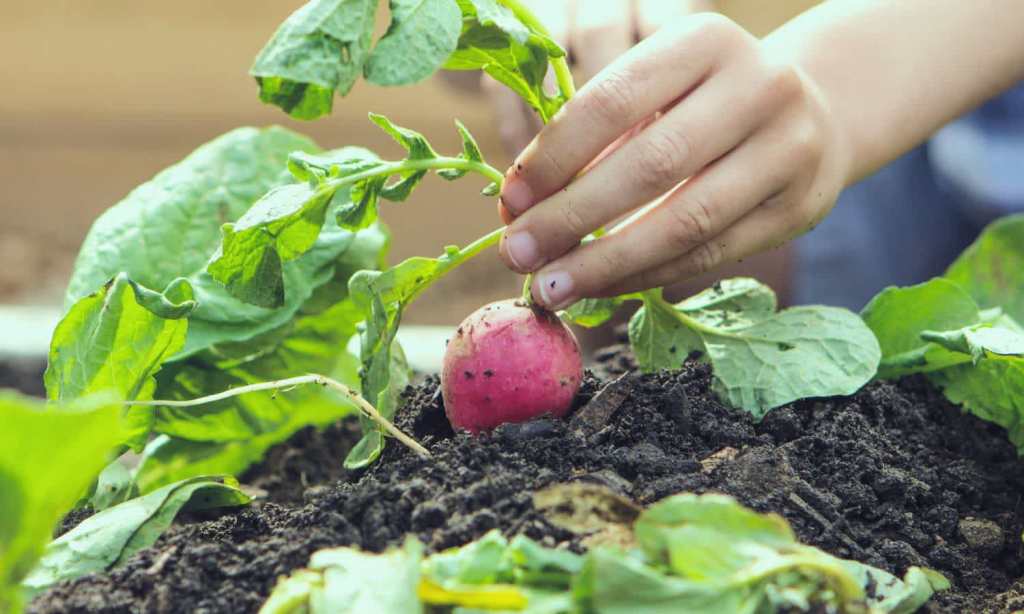The Latch has partnered with Suncorp Bank to deliver the sustainability content you need, from composting to growing your own veggie patch at home.
Many of us have dreams of growing our own vegetables — especially as the cost of groceries continues to rise. But even once you’ve picked up your tools and designed your home garden space, you still need to decide what to actually grow. There are several ways to decide which plants will thrive in your garden; one approach would be to look at your space from the lens of permaculture and the other is to start small and work your way to more advanced plants.
Related: Your Definitive Guide to Setting Up a Veggie Garden Using Permaculture Principles
Alternatively, you could use your space to grow a mix of perennials and annuals. Perennial plants regrow every spring, while annual plants live for only one growing season, and then die off. Perennials generally have a shorter blooming period than annuals, so it’s common practice to have a combination of both.
Ahead, we’ll look at five of the easiest, fuss-free vegetables you can start to grow through the year.
Salad Greens
A mix of salad greens like rocket, lettuce, endive, mustard greens, kale and chard are greens that grow well together in a garden patch.
Generally, you could start planting seeds in spring when the soil is warmer, but this depends on where you are in the country and how much heat you get. You could either demarcate your patch in rows and grow one type of salad green in each row or simply scatter a mixed bag of salad leaf seed mix on a patch of bare soil.

Cover the soil with about 2mm of compost, water regularly and watch as they grow from seed to seedling in weeks, and eventually to adult plants in about two months. Once you see the first outer leaves growing, you may harvest them and they will continue to regrow new leaves. At this point, you could also consider giving your greens about 5 – 10mm of space between each other so they can grow fuller and prevent overcrowding.
Spring Onions
Also known as shallots, spring onions are great, not just for garnish, but also for soup stock, marinades and spreads. They are also wonderfully easy to grow from storebought vegetables. Instead of throwing the last bits away, cut above the roots and watch them regrow when placed in water.
Related: From Root to Fruit, Here’s How to Grow Vegetables From Food Scraps (Yes Really)
To cultivate a more abundant harvest of spring onions, you can buy them in punnets at a nursery, where each will usually have about eight clumps of spring onions bunched together. You can either plant them into the soil whole or separate each stalk and plant them individually. Spring onions, as their name suggests, like spaces that are open and exposed to bright sunlight.
Within a few days of planting your spring onions, you will notice the spring onions standing upright and growing towards the sky. You should get new shoots in about three to six weeks and they also produce tiny little white flowers that mimic a daffodil, which holds seeds. You can harvest these seeds and plant them again or let nature take its course when they drop into the soil.
Beetroot
Most people are unaware that all parts of a beet can be eaten, from leaf to root. The fleshy, deep magenta staining fruit is what gets the most attention.
To grow beets, sow the seeds about 10mm deep and water them regularly to keep the soil moist. Beets are of the taproot family and can survive in any kind of soil. In about two months, you should find young, tender beet tops and once the beets are about two inches in diameter, you can tug gently at the greens and pull out the whole beet.
Peas and Snow Peas
Peas like growing in slightly cooler weather. If you’re somewhere where you get a lot of sunlight, it is best to grow peas in a shaded area of your garden.
Snow peas, in particular, are great for beginners because the white flowers of the snow peas turn from flower to pod within a few days, making the harvest period quick and easy.
To grow snow peas, sow the seeds about 5mm from one another and, if possible, build a trellis structure or set up a fence that allows these peas to climb up. Once they have caught on, they make for fast-growing, problem-free plants that yield lots of snow peas, best eaten close to harvest.
Lemon Balm
A garden patch allows for plenty of space for a herb patch. Herbs are tasty additions to almost any meal — or can even make a delicious tea by simply steeping the leaves in hot water — plus, they will also make your garden smell heavenly.
Lemon balm is a perennial herb, which means it regrows every spring. They grow as a bushy, leafy herb but can become invasive if not pruned and maintained.
Plant lemon balm seed in warm weather, with lots of sun, and at least 50 cm apart from one another. Then, cover the soil with 2 – 3cm of compost, watering regularly so the soil is damp but not drowning in water.
Lemon balm plants can grow up to 6-8 inches and will continue to grow with harvesting. Harvest the leaves by simply snipping off the leaves at the stems for use in cooking, teas, or as an air freshener.
These are just some of the basic, easy-to-start planting options for anyone with a garden patch. Once you have gotten into the groove of sowing, growing and harvesting, you can start to build your garden to accommodate seasonal vegetables of your liking.
Read more stories from The Latch and subscribe to our email newsletter.







